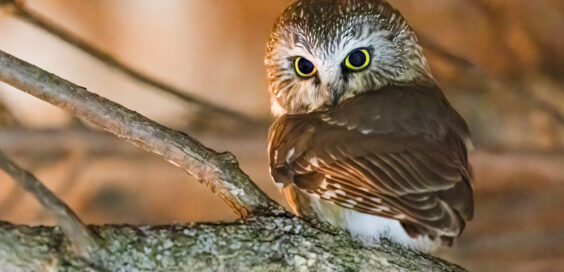
Creature Feature – Northern Saw-whet Owl
Posted by Dustin Horton // March 19, 2023 // Articles, Creature Feature
The Northern Saw-whet owl is one of the world’s smallest owl species, measuring just 7 – 8.5 inches tall. It has mottled brown and white plumage, a round head that appears too large for its body, a grey facial disk, and a pale “Y” between its eyes. This little owl occupies dense coniferous and hardwood forests throughout North America but is rarely detected due to its nocturnal nature and cryptic coloration.
The Saw-whet is one of just a few owl species that migrate seasonally, heading south in autumn and returning to its breeding range in spring. It is one of our most frequently banded owls – it flies low during migration and along narrow flight corridors, resulting in a concentration of Saw-whets within a small area. Licensed banders trap the bottlenecked birds in fine-mesh nets, then take various measurements before releasing them. The data helps increase our understanding of Saw-whets.
Silently roosting by day, the Saw-whet stirs at dusk to hunt mice and other small creatures with impressive accuracy. Prey is often cached, and in winter, the owl sits on frozen food to thaw it out. It nests in natural tree cavities and holes excavated by woodpeckers and squirrels. The female handles incubating and brooding, while the male does the hunting. Soon enough, he becomes a single dad, because when the owlets are around 18 days old, their mother departs and rarely, if ever, returns to care for them. Father Saw-whet remains devoted and feeds his young for at least one month after they fledge.
Article by Margie Manthey
Photo by Rob Julien













